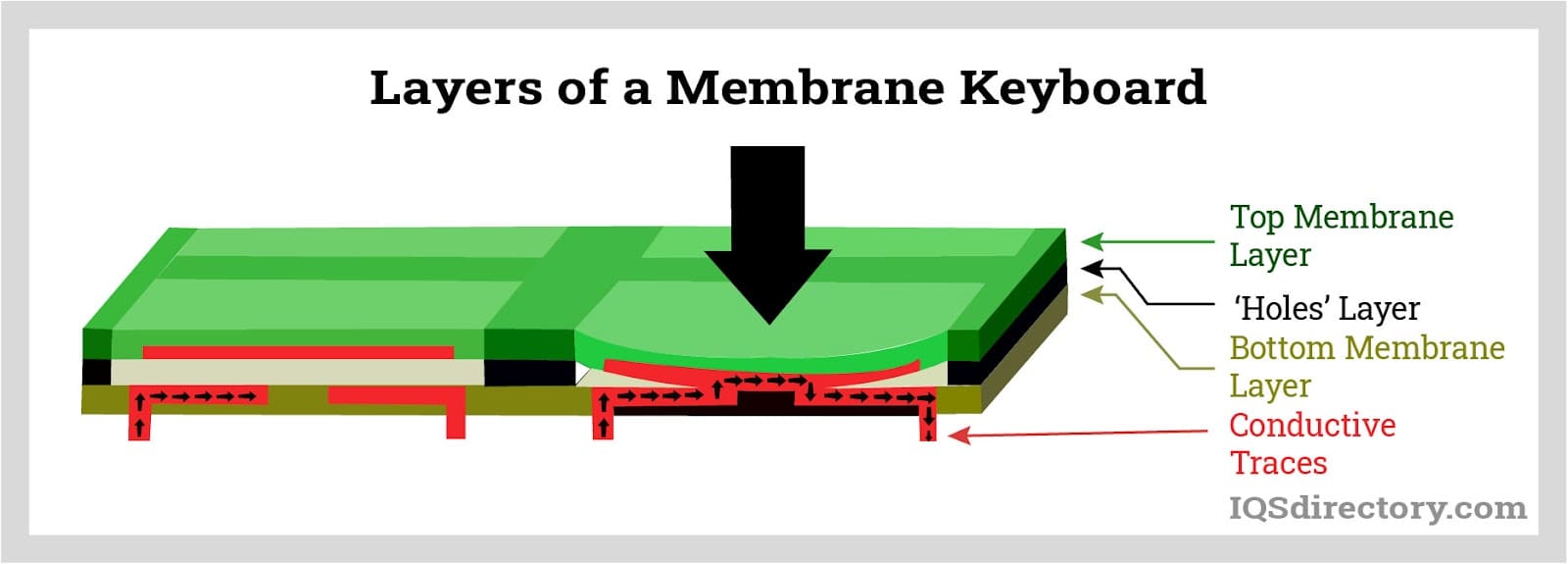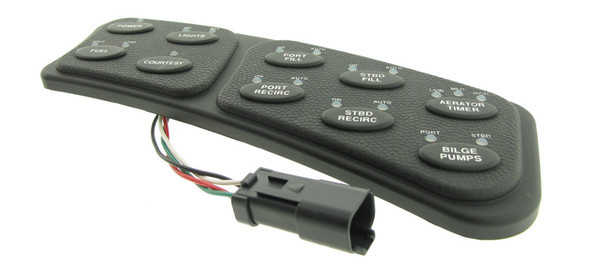All Concerning Membrane layer Switch: A Comprehensive Overview for Beginners
Membrane buttons are vital components in modern-day electronics, supplying an one-of-a-kind interface for customer interaction - membrane switch. Their split building, consisting of overlays and conductive traces, offers functionality and toughness. Unlike conventional mechanical buttons, membrane buttons present a smooth style and customizable options. Comprehending their key functions and advantages can transform item design. Nevertheless, the intricacies of their application and style factors to consider require more exploration
What Is a Membrane Switch over?
A membrane layer switch is a type of electric button that includes a versatile membrane layer layered over a published circuit board. This design enables for a compact and smooth user interface, often utilized in various electronic gadgets. Membrane layer buttons are generally located in customer appliances, clinical equipment, and industrial equipment as a result of their longevity and resistance to environmental factors.The building and construction commonly consists of numerous layers, such as visuals overlays and sticky backing, which offer responsive responses and secure the circuitry beneath. The operation of a membrane layer button is initiated when pressure is used to the surface, completing an electrical circuit.These switches are valued for their convenience, allowing personalized layouts and published graphics that deal with certain interface. Their low-profile nature lowers room requirements, making them ideal for applications where traditional buttons may not fit. Generally, membrane layer buttons use a visual and useful service for modern digital tools.
Key Components of Membrane Changes
Membrane changes make up a number of essential components that add to their capability and efficiency. The top layer, called the overlay, provides the interface and is usually printed with icons or graphics. Beneath the overlay exists a spacer layer, which divides the conductive aspects and prevents unintended activation. The following crucial part is the visuals layer, which improves appearances and ensures the longevity of the design.Conductive traces, usually made from products like silver or carbon, are published on the circuit layer. When stress is applied to the overlay, these traces enter call, completing the circuit. Furthermore, a support layer offers structural assistance and can be made from products such as polyester or polycarbonate. Together, these components produce a trustworthy, straightforward interface suitable for various applications, from home home appliances to commercial tools. Recognizing these elements is essential for any person interested in membrane layer button innovation.
How Membrane Switches Over Work
Comprehending exactly how membrane layer switches function is essential for appreciating their widespread use in various tools. A membrane switch runs through a series of layers, including a graphic overlay, spacer, and a circuit layer. When pressure is put on the overlay, it presses the spacer layer, enabling the circuit layer to make contact and complete an electric circuit. This action sends out a signal to the device, motivating an action, such as activating a light or activating a function.Membrane switches can be developed with different attributes, consisting of responsive feedback, backlighting, and customized graphics, improving individual communication. Their building and construction permits for a sealed design, protecting the internal elements from dust, wetness, and pollutants. This toughness makes them ideal for varied applications, from customer electronic devices to commercial equipment. Overall, the simplicity and effectiveness of membrane layer switches over add to their popularity in modern innovation.
Benefits of Membrane Layer Switches Over Over Mechanical Buttons
While mechanical buttons have long been a staple in numerous devices, membrane switches over deal unique advantages that make them progressively appealing. One significant benefit is their slim account, permitting even more small designs and better adaptability in product development. In addition, membrane layer changes function an uniform surface area, which improves aesthetic allure and streamlines cleaning, making them ideal for settings where hygiene is critical.Another advantage is their resistance to dust and wetness. Unlike mechanical buttons, which can be jeopardized by ecological aspects, membrane switches give a closed interface that secures versus impurities - membrane switch. In addition, membrane layer switches commonly have a longer life-span as a result of fewer i thought about this relocating parts, causing improved resilience and reliability.Cost-effectiveness is additionally a significant benefit, as membrane layer switches can be created wholesale with reduced manufacturing expenses. These variables combine to place membrane layer switches as a functional alternative to standard mechanical alternatives in various applications
Typical Applications of Membrane Layer Switches
Membrane buttons are extensively used in different sectors, especially in customer electronic devices and commercial control panels. In consumer gadgets, they give a sleek, easy to use interface, while in commercial setups, they enhance sturdiness and performance. Recognizing these applications highlights the versatility and practicality of membrane switches in contemporary innovation.
Customer Electronic Devices Instruments
As customer electronics proceed to evolve, membrane layer switches have become a prominent option for a selection of devices due to their flexibility and smooth style. These switches are typically discovered in mobile phones, tablet computers, and push-button controls, where area is restricted and aesthetics matter. Their reduced account and personalized styles enable makers to produce easy to use interfaces that enhance the overall customer experience. In addition, membrane layer switches are frequently used in appliances such as microwaves and coffee makers, giving instinctive control choices while withstanding moisture and dust. The longevity and integrity of membrane layer switches make them ideal for day-to-day consumer products, making certain durability and consistent efficiency. Generally, their combination in consumer electronic devices reflects a mix of functionality and modern layout.
Industrial Control Panels
The applications of membrane switches expand beyond consumer electronics, locating considerable use in commercial control panels. These buttons are favored for their durability and resistance to rough atmospheres, making them perfect for making and process control settings. They supply a reputable interface for operators to control equipment, display procedures, and adjust settings. Membrane layer switches can be tailored to suit certain operational requirements, incorporating functions like backlighting and responsive feedback, boosting user experience. Their low-profile layout enables for assimilation into numerous devices, while their capacity to endure spills, dirt, and extreme temperature levels guarantees longevity. Generally, membrane switches add to reliable and safe procedure in industrial applications, demonstrating their versatility and performance sought after atmospheres.
Factors To Consider for Creating Membrane Switches
When creating membrane layer buttons, picking the right materials is necessary to assure resilience and performance. Furthermore, recognizing layer arrangement strategies can significantly affect the button's performance and user experience. These considerations play an essential function in producing trusted and reliable membrane layer button layouts.
Product Choice Value
Material choice plays a necessary duty in the layout and capability of membrane layer buttons. The selected materials directly influence the button's toughness, responsive action, and general imp source aesthetic. Trick factors to consider consist of the substrate, which must provide architectural stability while permitting flexibility, and the visuals overlay, which requires to be resistant to wear and ecological aspects. Conductive materials should assure trustworthy electrical performance, while adhesives have to use strong bonding without compromising the button's operation. In addition, compatibility with making processes and end-user environments is crucial; materials must stand up to varying temperatures, moisture degrees, and chemical exposure. Ultimately, suitable material selection not just improves the membrane button's performance however also adds to its durability and customer contentment, making it an essential aspect of the layout process.

Layer Setup Strategies

Regularly Asked Concerns
The Length Of Time Do Membrane Layer Switches Over Commonly Last?
Membrane layer switches normally have a lifespan of 1 to 5 million cycles, depending upon use and environmental problems. Factors such as layout top quality and operating frequency substantially influence their toughness and overall performance long life.

Can Membrane Layer Switches Over Be Personalized for Particular Designs?
Membrane layer buttons can certainly be customized to accommodate details styles, permitting diverse forms, colors, and functionalities. This versatility makes it possible for makers to tailor these buttons to satisfy unique visual and operational requirements properly.
What Materials Are Used in Membrane Layer Switch Building And Construction?
Membrane buttons are generally created utilizing products such as polyester, polycarbonate, and adhesive layers. These products give resistance, sturdiness, and adaptability to ecological factors, making sure the buttons operate efficiently in different applications and problems.
Are Membrane Layer Switches Immune or water-proof to Dampness?
Membrane switches can be developed to be moisture-resistant, using specialized materials and coverings. Their water-proof abilities depend on construction high quality and particular applications, making it necessary to examine needs for excellent efficiency in numerous atmospheres.
Exactly How Are Membrane Changes Repaired if Harmed?
Fixing broken membrane switches generally involves replacing the influenced layer or circuit. Professionals might likewise apply conductive adhesive or make use of specialized fixing packages, making sure functionality is restored without full substitute of the entire switch setting up. Unlike standard mechanical switches, membrane layer buttons provide a sleek layout and adjustable options. A membrane layer button is a type of electric switch that consists of an adaptable membrane layered over a published circuit board. The procedure of a membrane button is initiated when stress is applied to the surface, finishing an electrical circuit.These buttons are valued for their flexibility, enabling custom-made designs and published graphics that cater to details individual interfaces. While mechanical switches have long been a staple in many gadgets, membrane changes offer unique benefits that make them progressively appealing. Membrane layer buttons commonly have a longer life expectancy due to fewer moving components, resulting in improved longevity and reliability.Cost-effectiveness is likewise a notable benefit, as membrane layer switches can be created in bulk with reduced manufacturing expenses.